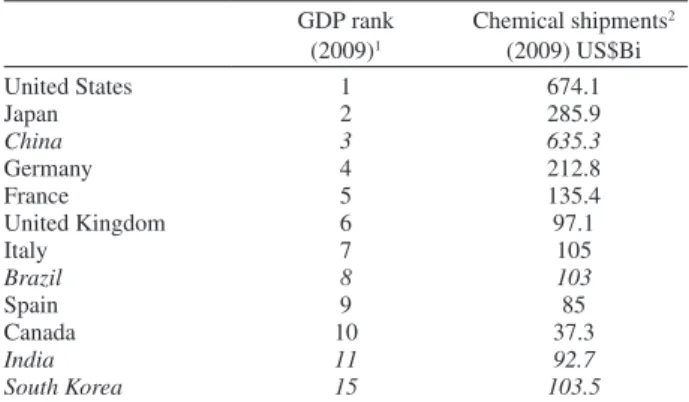Editorial
J. Braz. Chem. Soc., Vol. 22, No. 2, 196, 2011.
Printed in Brazil - ©2011 Sociedade Brasileira de Química 0103 - 5053 $6.00+0.00
e
An editorial normally contains text without igures, tables or pictures. This one is an exception because any person can easily discover the editorial message just by reading the accompanying Table 1. It has three columns: the irst is a list of the countries, ranked by their gross domestic product - GDP - in the second column while the third shows the value of the chemical shipments in each country. The GDP and chemical product from each country correlate well: the richest countries are also the world top chemical producers and vice-versa. However, there are a few exceptions: China, Brazil, India and South Korea rank higher as chemical producers than according to their GDPs. These four countries have one feature in common: they have fared well above the average since the global economic crash from 2008.
Two conclusions arise: overall economic product from a country is strongly tied to its chemical product and just observing chemical outputs easily allows the identiication of the most dynamic global economies.
This provokes one relection on the past and another on the future. In the early 80s from past century, the following sentence was often heard: “developed countries are exporting their polluting industries to poorer countries, where corruption impedes environmental control”. This was stated, for instance, by many opponents of the PADCT - Support Program for Scientiic and Technological Development - the national program for the development of science and technology that then revolutionized Brazilian chemistry. Thirty years later, the reality is this: the wealthy countries kept their outstanding positions as chemical producers and the US is by far the largest current producer of sulfuric acid - the most basic of all industrial products - in the world.
The preservation, renewal and growth of the chemical industry required national and regional ine-tuned policies, fueled by large investment. For instance, from 1990 onwards, what was then left from the famous Leuna Werke
Alchemy in the 21
stCentury
in the reunited Germany changed into a vigorous chemical site now publicized by beautiful pictures where green is the prevailing color.
Thus, if Brazil really makes an option for economic growth on a sustainable basis, its chemical industry has to be further strengthened and this requires great effort from entrepreneurs, engineers, scientists, planners and all the professionals involved in this area. No doubt, large investment will be needed.
Unfortunately, many Brazilian official documents ignore all the facts mentioned above. Plans from the Ministry of Science and Technology are conspicuous for the absence of the words “chemistry” and “chemical”. This is even more surprising because the Brazilian chemical industry, showing great vision and spirit of enterprise, is fast incorporating biomass products to its raw materials, taking giant steps in the transition to a less oil-dependent world.
This pioneer attitude has deep roots in this country, represented by the Usina Serra Grande in Alagoas State (Northeastern Brazil) - a “fuel factory” from a blend of ethanol, diethyl ether and castor oil for the cars sold in the 20s - and also by the irst large alcohol-chemical plant, opened in the then municipality of Campinas, State of São Paulo (Southeastern Brazil), in 1942.
We are now starting the celebration of the International Year of Chemistry-IYC.3 In Brazil, we can be sure to be
celebrating also the improvement of living conditions for large populations, especially the poorer. We are now celebrating more and better food, more drinking water, more energy, more cultural ware and well-being, for all. We celebrate but with due attention to the lessons from History, knowing that we chemists can also make huge mistakes, but we know how to avoid and to correct them.
In this IYC, chemists and those who practice, love and admire Chemistry can feel proud of their outstanding role in the great saga of humankind. This should give us all new energy for the supreme task: to educate the new generations into Chemistry for the mankind, teaching them to use this knowledge while taking any decisions. May the young learn to create, discover, produce and use ever more Chemistry, for the future of people and the planet.
Fernando Galembeck - Unicamp
References
1. International Monetary Fund, World Economic Outlook
Database, October 2010: Nominal GDP list of countries. Data
for the year 2009.
2. http://www.americanchemistry.com/s_acc/sec_directory. asp?CID=292&DID=747, accessed in December 2010. 3. Pinto, A. C.; J. Braz. Chem. Soc.2009, 20, No. 3, iii.
Table 1. Countries ranked according to their GNPs and the respective chemical production value
GDP rank (2009)1
Chemical shipments2 (2009) US$Bi
United States 1 674.1
Japan 2 285.9
China 3 635.3
Germany 4 212.8
France 5 135.4
United Kingdom 6 97.1
Italy 7 105
Brazil 8 103
Spain 9 85
Canada 10 37.3
India 11 92.7
